It may seem to be an oxymoron but, on the contrary, “being in the midst of the edge” has been the constant condition that made our project possible. Considering the centrality of the margin has been one of the threads, a red thread, leading all the discussions, experimentations and experiences of the event Into the Midst: Immersion ~ Emergent. After months of preparation, the project took place in October 2012 in Montreal, where 26 people of the SenseLab (Concordia University) gathered for a week-long residency at the Society for Arts and Technology (SAT). This residency culminated with a final public event on the last day, October 22.
During the entire process, questions of space, particularly in relation to the notions of margin, centre, interior and exterior space, emerged from our discussions. First, we met through online communication technologies, holding regular Skype meetings and exchanging information on a web collaboration platform. Readings and discussions were supposed to open up a collective process, or as discussed by Arakawa and Gins, a landing site. A site of landing, a point of contact, of folding and unfolding possibilities between us and the space we were working in, an “organism-person-environment1.”

The Context: a Central Marginal Site
The last phase of the project, nourished by the speculative work done during almost ten months, brought us together in the space were the Society for Arts and Technology (SAT) is located. The SAT, with its immersive, impressive, dark, high-tech environment of the SATosphère (the Dome), is sited in the east of downtown Montréal. As a part of the brand new Quartier des spectacles, a sparkly entertainment-themed neighbourhood partly overlapping the former Red-Light district, the SAT participates in the revitalisation project of an urban area that is largely frequented by a marginalized population and considered as problematic for the city’s image.
Not far from the SAT you can bump into strip-tease clubs, erotic cinemas and all the vestiges of a by-gone era related to the Red-Light district, at its apogee in the first half of the twentieth century and by then threatened by various city’s urban politics, such as the Quartier des spectacles project2. Moreover, the SAT overlooks the boulevard Saint-Laurent, known by Montrealers as la Main. The main street of the city is the protagonist of Montréal’s collective imaginary through books, theatre plays, public inquiries, news stories and people’s everyday life. The boulevard divides the city’s urban fabric into East and West, a symbolic line separating the two founding communities of Montreal, francophone and anglophone, which historically and mythically settled on the two sides of the island. At the same time it has hosted the incoming immigrants for whom this singular combination of centrality and marginality with its peculiar cultural eclecticism provided an ideal location to access urban and social spaces of Montréal.

The Process: Blurring the Margin between Interior and Exterior
The new high-tech environment of the SATosphère, as a synecdoche of the glittering Quartier des spectacles, clashes with its surroundings. Near the economic and financial downtown, the supposed cultural and artistic heart of Montréal is located on a central margin.
This clash is crucial in our collective reflection: how can we relate the exterior’s controversial aspects to the tidy interiors of this innovative space? How do we activate the edges of a space that draws all attention to its centre?
We decide to take action not only in the Dome, but also outside.
We pick up a colour: Red.
Red as the Red Light District.
Red as the logo of the Quartier des spectacles.
Red as the colour of the student protests in Montréal3.
We experience the surroundings in many ways: moving, dancing, crocheting, eating, talking, videotaping, taking photos, scanning, recording sounds. Through direct interpellation, we try to engage, unsuccessfully, with people in the street. We spend an entire day in the park right outside the SAT, the place de la Paix, where shoes hanging on trees or electric lines indicate some information that we cannot really decode, but we can guess4. The square is populated by a number of marginalized persons, including drug-dealers and consumers, sex workers, homeless people etc.
We share food, we crochet, we scan and simply make public our bodily presence; we sometimes feel unwelcome. We videotape our bodies in movement right in front of a strip-club; it is closed, too early in the day. It is truly an experience of being in the midst of an edge. The edge between daily and night activities, between what is considered as socially acceptable and what is not. Our techniques are at the margin, the edge between normative framed practices and marginal coded activities; we feel unwelcome or observed with suspicion and curiosity. We bring back to the Dome all these materials and our experience.
The environment of the SATosphère directs all efforts towards and concentrates all expectation in the middle. As a spectator, the upper centre of the Dome, at 13 metres high, relentlessly attracts you. You feel an inexorable urge to sit or lie down on the huge cushions and watch the centre of the spherical envelope right above you.
How to change this spatial configuration by other means than projecting images on the surface of its envelope? How to engage with people to let them have an immersive experience, embodied in the proper sense of the word?
We decide to use the technological tools offered by the SAT (a spherical-moving 360° wide screen; loudspeakers; a Ladybug camera; video, image and sound software, and programmers) but also our own artistic and technological skills and other “raw materials” like bodies, crochets and yarn, paper, helium balloons. Our goal is to activate the edges: the lower parts of the screen, all around us; the floor often forgotten; the middle space in between the floor and the upper part.

The End (?): Following the Red Thread
October 22, 5p.m. The public event inexorably starts. We keep on repeating to ourselves: this is neither a show nor a performance. Many of us feel the pressure. This is the awkward moment of the process, the time to show something to people and to explain the meaning of the project, the time when occupying the space feels like taking a position.
We project images, scans and videos; we use our sound recordings through the 157 speakers. We disassemble the big cushions and create a messy maze, leaving the edges clear of any obstacle that could stop the experience, while serving tea and crocheting with people. We loose a helium balloon trying to occupy the middle space between the ground and the top roof. We play, we run, we sit and we talk.

A few minutes before the public event starts, whilst crocheting, we decide to bring the red yarns from the interior space of the Dome to the outside, as we have been crocheting outdoors the entire week. Red threads now connect the SATosphère to the exterior, some of them lying on the sidewalk, some knotted to a bike and others climbing a tree. Bringing the yarn outside feels almost like liberation. Personally, I feel as if I do not want to go back to the Dome, this is the right place for me. The red threads seem to take away the pressure of the event, leading us right into a milieu where the margins between interior and exterior are blurred.
At the end, we hold a public discussion and we finally relax. A girl raises her hand and says: “while I was coming here I found this red yarn on my path. After the first surprised glance, I see that it is bringing me right into the Dome, stopping with small knots on trees, hiking on brick walls and bikes. Arriving here I found a big net of knits, threads and bodies, right in the Dome. I found it poetic, the essence of this event.”
If we did not know where we were going, at that precise moment it became clear: the red thread was bringing us back into the midst of the edge.
Notes
[1] Arakawa and Madeleine Gins. Architectural Body. Tuscaloosa: The University of Alabama Press, 2002, p. 6.
[2] The Quartier des spectacles project is a branding venture, launched by the city in 2007, aiming to create a themed district promoting the production and consumption of culture. The Red Light district has constituted one of the most important sexual business areas in North America. It started with the ratification of prohibitionist laws in the United States at the end of the 1910 and has been active until the fifties, when municipal politics led a campaign on morality with strong interventions and public inquiries. Today the sector is a strange and scattered mishmash of sexual businesses and cultural venues.
[3] The symbol of the Québec student protest that fights against the augmentation of tuition fees, and more widely the commodification of knowledge, is a red square. The red square refers to the French expression “carrément en rouge”, pointing at the precarious economic situation of students.
[4] Flinging and hanging shoes on cables, power lines and tree branches (known also as shoefiti) has several and mythical explanations spanning from gang and drug-related activities, to bullying behaviours or social and art practices.
